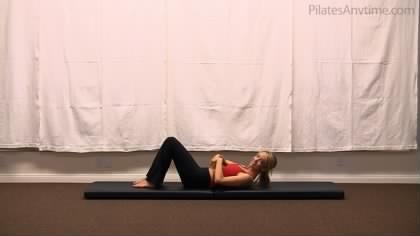Diastasis Recti Information
Leah Stewart
Tutorial 1463
Watch this Tutorial
Hi Emma,
Before I answer your question, I have one. When did your client begin practicing Pilates after the birth of her baby?
Thank you!
Leah
Before I answer your question, I have one. When did your client begin practicing Pilates after the birth of her baby?
Thank you!
Leah
9 years ago
I'd love to see what your answer is on the comment above. In my case, there is an ongoing umbilical hernia that keeps protruding when there is too much forward flexion or any twisting in the torso. It also gets worst in back extensions and in any push-up position as in the Long Stretch. And lastly, too much resistance on the arm work can also affect it. As you can imagine there are too many exercises to eliminate, especially any ab work. Any feedback would be extremely helpful, thank you!
9 years ago
Emma - I wanted to answer your question now  So.....discussing a diastasis recti can be a tricking thing, because honestly, you'll find different opinions from many professionals. I'll briefly explain my thoughts and why. First, any diastasis recti under two finger tips width in the initial post partum period (1 - 6 months) is considered normal and not problematic (this is of course a bit of a loaded statement, because it is too often the case that women after having babies exacerbate and create a worse DRA by doing the wrong exercises too soon). If correct exercises and correct body mechanics are done, that "natural" separation should decrease within those 6 months. continued.....
So.....discussing a diastasis recti can be a tricking thing, because honestly, you'll find different opinions from many professionals. I'll briefly explain my thoughts and why. First, any diastasis recti under two finger tips width in the initial post partum period (1 - 6 months) is considered normal and not problematic (this is of course a bit of a loaded statement, because it is too often the case that women after having babies exacerbate and create a worse DRA by doing the wrong exercises too soon). If correct exercises and correct body mechanics are done, that "natural" separation should decrease within those 6 months. continued.....
 So.....discussing a diastasis recti can be a tricking thing, because honestly, you'll find different opinions from many professionals. I'll briefly explain my thoughts and why. First, any diastasis recti under two finger tips width in the initial post partum period (1 - 6 months) is considered normal and not problematic (this is of course a bit of a loaded statement, because it is too often the case that women after having babies exacerbate and create a worse DRA by doing the wrong exercises too soon). If correct exercises and correct body mechanics are done, that "natural" separation should decrease within those 6 months. continued.....
So.....discussing a diastasis recti can be a tricking thing, because honestly, you'll find different opinions from many professionals. I'll briefly explain my thoughts and why. First, any diastasis recti under two finger tips width in the initial post partum period (1 - 6 months) is considered normal and not problematic (this is of course a bit of a loaded statement, because it is too often the case that women after having babies exacerbate and create a worse DRA by doing the wrong exercises too soon). If correct exercises and correct body mechanics are done, that "natural" separation should decrease within those 6 months. continued.....
9 years ago
In saying that, please remember that there is a natural space between both the right and left sides of the rectus abdominis where the linea alba lies. So, you will feel those two vertical bands of the RA (particularly when the RA is engaged with out the synergist use of the other abdominal muscles). Often after a woman is pregnant those bands are more pronounced due to the changes, shifts and extreme stretching both the abdominal muscles and the linea alba experienced during pregnancy. continued.....
9 years ago
In my experience, we as Pilates professionals - pre- and post-natal Pilates professionals, really need to define exactly what a DRA is. What is "normal" and what is problematic. In my research, experience and practice if a woman has a separation wider than two finger tips - then we have a DRA issue (exercise integrity will be compromised because the muscles are not aligned to work effectively and efficiently). Of course if a woman is under the two finger tip width, this doesn't mean we throw exercise caution to the wind and pile on the intense and loaded flexion exercises (that would most likely create the DRA our client didn't have in the first place). We still need to rehabilitated those over-stretched, weakened, stressed abdominal muscles which can take 6 - 12 months dependent on many subjective factors. continued.....
9 years ago
It sounds like you have taken a very conservative and safe approach with your client, and I really applaud you for that!! Bravo!! And you are right, with good, sound, abdominal recruitment your client should be able to perform some forward, loaded flexion exercises. And yes, when fatigue starts to set in and the movement integrity becomes compromised, it is time to stop. In fact, I have seen clients with a mild DRA but with great body awareness, muscle recruitment, strength and endurance, as well as body mechanics be able to safely and beneficially perform classic Pilates exercises that have forward flexion (The Hundred, Double Leg Stretch, etc). continued....
9 years ago
Some women will never be able to "close" that gap beyond 1, 1 1/2 or so finger tips due to so many variables, but yet, with patience, mindful movement and progressive intelligent movement, they are able to incorporate some flexion and abdominal sequences into their normal Pilates routine - they are not banished to a Pilates live sans Single Leg Stretch forever. It may be modified, etc, but they have learned how to stabilize and recruit properly therefore, they can do them safely. It sounds as if your client is on that track, with your help she has healed from pregnancy and labor, she as safely rehabilitated and re-learned how to use her abdominal muscles. If you feel she is ready, it may be a smart time to introduce some traditional Pilates abdominal exercises - that is of course, if all the integrity stays intact (which I know you know 

9 years ago
Those are my general thoughts on the topic without knowing the details of your client or what exercises you have given her as well. And lastly, as you probably well know, it is not only loaded forward flexion exercises that can be problematic for DRA, any time we put too much or undue stress or strain on the abdominal muscles when they are compromised or not in the best condition to handle such movements or intensity, it increases the risk for DRA - planks, intense seated work and yes, even our "approved" modified pre and post-natal Pilates exercises, to name a few, when done incorrectly or in a ROM not suitable for that client can potentially create an undesired affect.
So...okay...that wasn't brief..... But, I do hope that helped a bit. Please let me know if you have any other questions or thoughts or if you need any clarificiation on my thoughts. I'm always happy to answer and help if I can.
But, I do hope that helped a bit. Please let me know if you have any other questions or thoughts or if you need any clarificiation on my thoughts. I'm always happy to answer and help if I can.
All the best,
Leah
So...okay...that wasn't brief.....
 But, I do hope that helped a bit. Please let me know if you have any other questions or thoughts or if you need any clarificiation on my thoughts. I'm always happy to answer and help if I can.
But, I do hope that helped a bit. Please let me know if you have any other questions or thoughts or if you need any clarificiation on my thoughts. I'm always happy to answer and help if I can. All the best,
Leah
9 years ago
Theodora,
Thank you for your thoughts and question. A hernia makes in particularly difficult to perform abdominal work or any exercise where abdominal and trunk stabilization is vital (as you said, intense arm work, plank positions, etc). I would first suggest you really speak to either your OBGYN or a PT regarding this, and explore ways they may help you correct this. Because a hernia is not a condition that can be rectified with exercise. continued.....
Thank you for your thoughts and question. A hernia makes in particularly difficult to perform abdominal work or any exercise where abdominal and trunk stabilization is vital (as you said, intense arm work, plank positions, etc). I would first suggest you really speak to either your OBGYN or a PT regarding this, and explore ways they may help you correct this. Because a hernia is not a condition that can be rectified with exercise. continued.....
9 years ago
1-10 of 24
You need to be a subscriber to post a comment.
Please Log In or Create an Account to start your free trial.













I have a question about a client of mine. She is almost a year post partum and has a one finger width diastasis recti. She feels ready to incorporate some forward flexion back into her routine but I worry about potentially increasing her diastasis recti with forward flexion.
I feel if she can really focus and connect with her abdominal/TA engagement throughout she will be able to gently add in forward flexion. Taking it easy when her abdominals become fatigued too.
I'd love to hear your thoughts.
Emma x